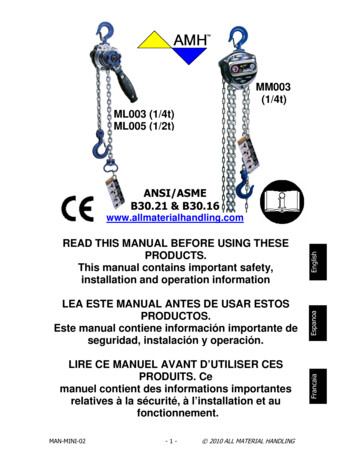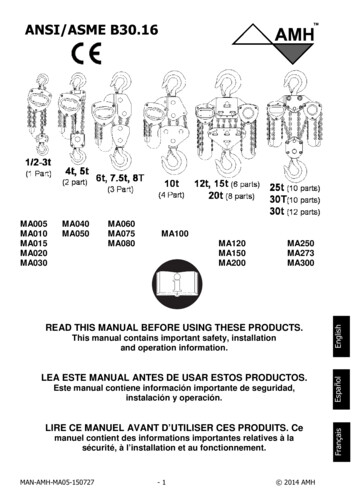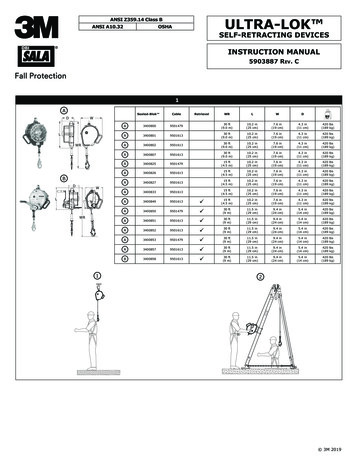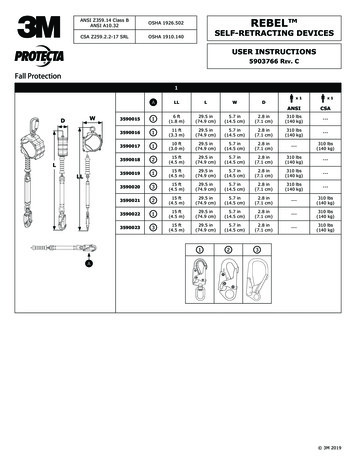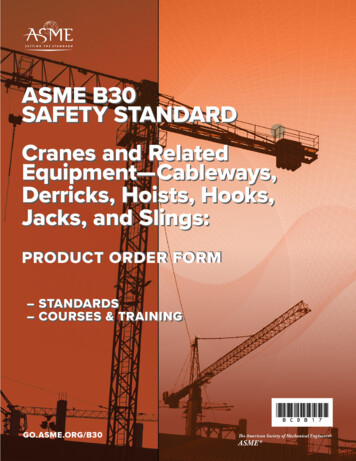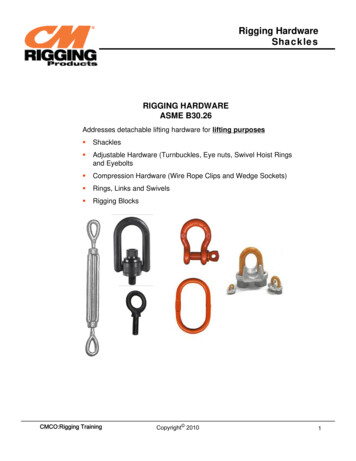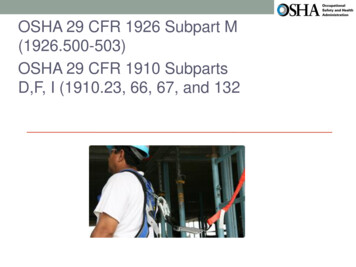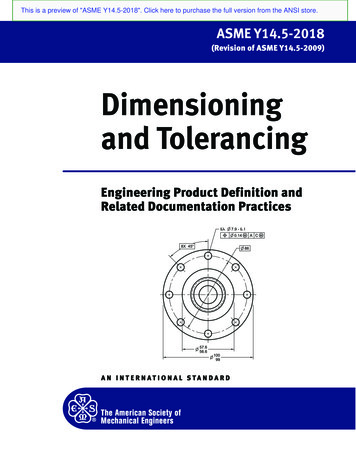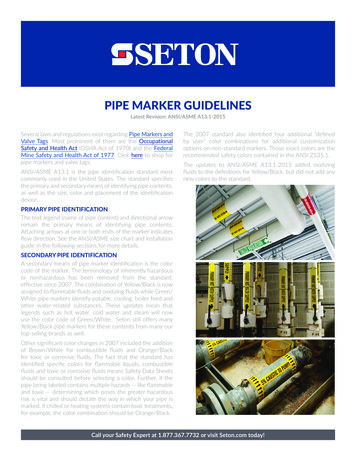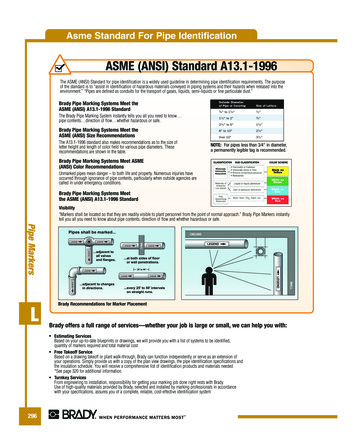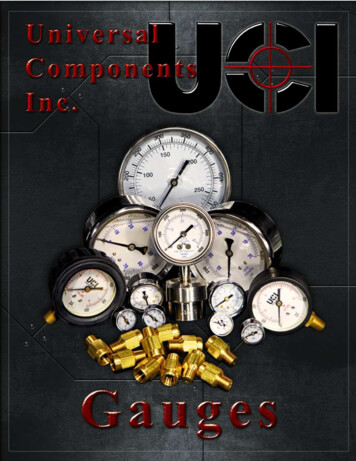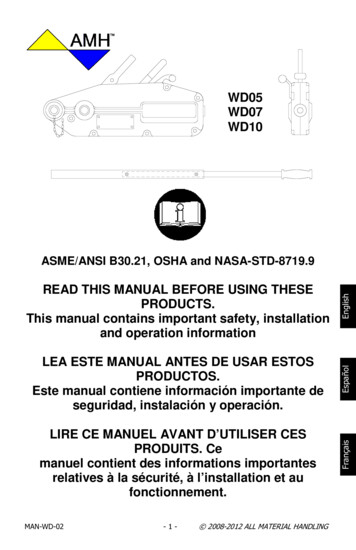
Transcription
WD05WD07WD10LIRE CE MANUEL AVANT D’UTILISER CESPRODUITS. Cemanuel contient des informations importantesrelatives à la sécurité, à l’installation et aufonctionnement.MAN-WD-02-1- 2008-2012 ALL MATERIAL HANDLINGEspañolLEA ESTE MANUAL ANTES DE USAR ESTOSPRODUCTOS.Este manual contiene información importante deseguridad, instalación y operación.FrançaisREAD THIS MANUAL BEFORE USING THESEPRODUCTS.This manual contains important safety, installationand operation informationEnglishASME/ANSI B30.21, OSHA and NASA-STD-8719.9
This manual provides important information for all personnel involved with the safe installationand operation of these products. Even if you feel you are familiar with this or similar equipment,you should read this manual before operating the product.EnglishAMH recognizes that most companies who use hoists have a safety program in force in theirplants. In the event you are aware that some conflict exists between a rule set forth in thispublication and a similar rule already set by an individual company, the more stringent of the twoshould take precedence. Safe Operating Instructions are provided to make an operator awareof unsafe practices to avoid and are not necessarily limited to the following list. Refer to specificsections in the manual for additional safety information. Safe Operating Instructions areprovided to make an operator aware of unsafe practices to avoid and are not necessarily limitedto the following list.1. Only allow people, trained in safety and operationof this product, to operate the hoist.2. Only operate a hoist if you are physically fit to doso.3. When a “DO NOT OPERATE” sign is placed on thehoist, do not operate the hoist until the sign hasbeen removed by designated personnel.4. Before each shift, the operator should inspect thehoist for wear or damage.5. Never use a hoist which inspection indicates isworn or damaged.6. Periodically, inspect the hoist thoroughly andreplace worn or damaged parts.7. Lubricate the hoist regularly.8. Do not use hoist if hook latch has been sprung orbroken.9. Check that the hook latches are engaged beforeusing.10. Only lift loads less than or equal to the ratedcapacity of the hoist. See "SPECIFICATIONS"section.11. If overloaded a shear pin will fail, releasing tensionon the handle, and may cause the operator to fall12. When using two hoists to suspend one load, selecttwo hoists each having a rated capacity equal to ormore than the load. This provides adequate safetyin the event of a sudden load shift.13. Never place your hand inside the throat area of ahook.14. Never use the hoist cable as a sling.15. Never operate a hoist when the load is notcentered under the hook. Do not “side pull” or“yard.”16. Never operate with twisted, kinked, or damagedcable.17. Do not force a hook into place by hammering.18. Never insert the point of the hook into a chain link.19. Be certain the load is properly seated in the saddle of the hook and the hook latch isengaged.20. Do not support the load on the tip of the hook.21. Never run the cable over a sharp edge.22. Pay attention to the load at all times when operating the hoist.23. Always ensure that you, and all other people, are clear of the path of the load. Do not lift aload over people.24. Never use the hoist for lifting or lowering people, and never allow anyone to stand on asuspended load.MAN-WD-02-2- 2008-2012 ALL MATERIAL HANDLING
25. Do not use a cheater bar or extender handle.26. Do not swing a suspended load.27. Never weld or cut on a load suspended by the hoist.28. Never use the hoist cable as a welding electrode.29. Do not operate hoist if excessive noise, jamming, overloading, or binding occurs.30. Only operate the hoist with manual power.31. After use, or when in a non-operational mode the hoist should be secured againstunauthorized and unwarranted use.32. Do not leave a load suspended when the hoist is unattended or not in use.STORING THE HOISTAlways store the hoist in a no load condition.Wipe off all dirt and water and hang in a dry place.Lubricate the cable, pins and hook latch.Before returning hoist to service follow instructions for ‘Hoists not in Regular Service’ in the“INSPECTION”Frequent and periodic inspections should be performed on equipment in regular service.Frequent inspections are visual examinations performed by operators or service personnelduring routine hoist operation. Periodic inspections are thorough inspections performed bypersonnel trained in inspection and maintenance of the hoist. Careful inspection on a regularbasis will reveal potentially dangerous conditions while still in the early stages, allowingcorrective action to be taken before the condition becomes dangerous. Deficiencies revealedthrough inspection, or noted during operation, must be reported to an appointed person. Adetermination must be made as to whether a deficiency constitutes a safety hazard beforeresuming operation of the hoist.1.2.3.4.Some form of inspection record should be maintained for each hoist, listing all points requiringperiodic inspection. A written report should be made monthly on the condition of the criticalparts of each hoist. These reports should be dated, signed by the person who performed theinspection, and kept on file where they are readily available for review.Frequent InspectionOn a hoist in continuous service, frequent inspection should be made at the beginning of eachshift. In addition, visual inspections should be conducted during regular service for any damageor evidence of malfunction.1. OPERATION. Check for visual or abnormal noises which could indicate a potential problem.Do not operate a hoist unless the cable feeds through the hoist and hook block smoothly.Listen for “clicking”, binding or malfunctioning. The clicking sound of the pawl on the ratchetgear is normal when a load is being raised. If problem persists, return the hoist to yournearest repair center. Do not operate the hoist until all problems have been corrected.2. HOOK LATCH. Check operation of the hook latch. Replace if broken or missing.3. HOOKS. Check for wear or damage, increased throat width, bent shank or twisting of hook.Replace hooks which exceed the throat opening discard width (15%) shown in Table 1 (ref.Dwg. H-01) or exceed a 10 twist (ref. Dwg. H-01). If the hook latch snaps past the tip of thehook, the hook is sprung and must be replaced. Check hooks swivel easily and smoothly.Repair or lubricate as necessary.Periodic InspectionFrequency of periodic inspection primarily depends on the severity of yDisassembly may be required for HEAVY or SEVERE usage. Keep accumulative written recordsof periodic inspections to provide a basis for continuing evaluation. Inspect all items in “FrequentInspection.” Also inspect the following:MAN-WD-02-3- 2008-2012 ALL MATERIAL HANDLINGEnglishRecords and Reports
1. FASTENERS. Check rivets, capscrews, nuts, cotter pins and other fasteners on hooks andhoist body. Replace if missing and tighten or secure if loose.2. ALL COMPONENTS. Inspect for wear, damage, distortion, deformation and cleanliness. Ifexternal evidence indicates the need for additional inspection return the hoist to your nearestservice repair center.3. HOOKS. Inspect hooks for cracks. Use magnetic particle or dye penetrant to check forcracks. Inspect hook retaining parts. Tighten or repair, if necessary. Refer to applicablespecifications for additional hook inspection information.4. DRUM and SHEAVES Check for damage or excessive wear. If damage or wear is noted,return the hoist to your nearest service repair center.5. LABELS AND TAGS. Check for presence and legibility. Replace if necessary.Hoists not in Regular Service1. Hoists which have been idle for a period of one month or more, but less than one year shouldbe given an inspection conforming with the requirements of "Frequent Inspection" beforebeing placed in service.2. Hoists which have been idle for a period of more than one year should be given a completeinspection conforming with the requirements of "Periodic Inspection" before being placed inservice.3. Standby hoists should be inspected at least semi-annually in accordance with therequirements of "Frequent Inspection." In abnormal operating conditions equipment should beinspected at shorter intervals.EnglishLubricationGeneralThe use of thread lubricant or anti-seize compound is recommended for threaded components.Unless otherwise stated, remove old lubricant, clean the part with an acid free solvent and applya new coating of lubricant to the part before assembly.1. Lubricate cable weekly. Apply new lubricant over existing layer.2. In severe applications or corrosive environment, lubricate more frequently than normal.3. Lubricate hook and hook latch pivot points with the same lubricant used on the cable.4. To remove rust or abrasive dust build-up, clean cable with acid free solvent. After cleaning,lubricate the cable.5. Use a SAE 50 to 90 EP oil.MAN-WD-02-4- 2008-2012 ALL MATERIAL HANDLING
1 YEAR LIMITED WARRANTYEnglishWe make every effort to assure that our products meet high quality and durability standards andwe warrant to the original consumer of our products that each product be free from defects inmaterial and workmanship as follows:1 Year limited warranty on all our products. The warranty does not apply to defects due directlyor indirectly to misuse, negligence or accidents, repairs or alterations outside our facilities or to alack of maintenance. We limit all warranties to the period specified above from the date theproduct was purchased at retail. Please retain your dated sales receipt as proof of purchase tovalidate the warranty period. Except as stated herein, any implied warranties or merchantabilityand fitness are excluded. Some states do not allow limitations on how long the warranty lasts;hence the above limitation may not apply to you. We shall in no event be liable for death, injuriesto persons or property or for incidental, contingent, special or consequential damages arisingfrom the use of our products. Some states do not allow the exclusions or limitation of incidentalor consequential damages; hence the above limitations or exclusions may not apply to you. Totake advantage of this warranty, the product must be returned for examination, postage prepaidto an authorized service station. Proof of purchase date and an explanation of the complaintmust accompany the product. If our inspection discloses a defect we will either repair or replacethe product or refund the purchase price, if we cannot quickly provide a repair or replacement, ifyou are willing to accept such a refund. We will return repaired products or the replacement atour expense, but if we find that there is no defect, or that the defect resulted from causes notwithin the scope of this warranty, then the user must bear the cost of returning the product. Thiswarranty gives you specific legal rights, and you may also have other rights that vary from stateto state.INOUTNoShear PinadLoseealeReaggEnINOUTControlsMAN-WD-02-5- 2008-2012 ALL MATERIAL HANDLING
Este manual ofrece información importante para todo el personal involucrado con la instalacióny operación segura de estos productos. Incluso en el caso de que usted considere que conocebien este equipo, u otro semejante, debe leer este manual antes de operar este producto.EspañolAMH reconoce que la mayoría de compañías que utilizan polipastos tienen un programa deseguridad vigente en sus plantas. En el caso de que usted se entere de la existencia deconflicto entre una norma establecida en esta publicación y una semejante ya establecida poruna compañía determinada, tendrá prioridad la más exigente de las dos. Las Instruccionespara la operación segura se proporcionan para alertar al operador sobre las prácticas insegurasque se deben de evitar, y no necesariamente se limitan a la lista que sigue a continuación.Para obtener más información de seguridad, consulte las secciones específicas del manual.1. Sólo se debe permitir que operen el polipasto laspersonas entrenadas en la seguridad y operaciónde este producto.2. Una persona debe operar el polipasto sólo si esfísicamente apta para ello.3. Si hay en el polipasto un aviso de “NO OPERAR”,no lo use hasta que el personal designado hayaquitado el aviso.4. Antes de cada turno el operador debe inspeccionarel polipasto para determinar si está desgastado odañado.5. Nunca opere un polipasto si la inspección indicaque está desgastado o dañado.6. Periódicamente haga una inspección exhaustivadel polipasto y reemplace las piezas desgastadaso dañadas.7. Lubrique el polipasto con regularidad.8. No utilice el polipasto si el pestillo del gancho estávencido o roto.9. Antes de usar el polipasto, compruebe que lospestillos de los ganchos están asegurados.10. Levantar solamente las cargas inferior o igual lacapacidad clasificada del alzamiento. Ver lasección de las “ESPECIFICACIONES”.11. Si está sobrecargado un perno de esquileo fallará,aflojando la tensión en la manija, y puede hacer aloperador caerse.12. Cuando use dos polipastos para suspender unacarga, seleccione dos polipastos que tengan cadauno una capacidad nominal igual o mayor que lacarga. Esto provee seguridad adecuada para elcaso de un cambio repentino de la carga.13. Nunca ponga la mano dentro del área de lagarganta de un gancho.14. Nunca use la cable de carga del polipasto comoeslinga.15. Nunca accione un polipasto si la carga no estácentrada bajo el gancho. No “tire lateralmente” dela carga.16. Nunca accione un polipasto con el cable de carga retorcido, angulado, “invertido” o dañado.17. No haga entrar a la fuerza una cadena o gancho usando un martillo.18. Nunca introduzca la punta del gancho en un eslabón de la cadena.19. Compruebe que la carga esté correctamente asentada en el lomo del gancho y que elpestillo del gancho esté asegurado.20. No deje que la punta del gancho soporte todo el peso de la carga.21. Nunca haga correr el cable de
ASME/ANSI B30.21, OSHA and NASA-STD-8719.9 READ THIS MANUAL BEFORE USING THESE PRODUCTS. This manual contains important safety, installation and operation information LEA ESTE MANUAL ANTES DE USAR ESTOS PRODUCTOS. Este manual contiene información importante de seguridad, instalación y operación. LIRE CE MANUEL AVANT D’UTILISER CES PRODUITS. Ce
